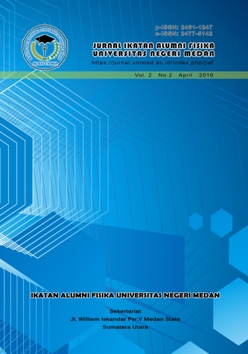THE EFFECT OF PROBLEM BASED LEARNING MODEL ASSISTED CONCEPT MAP TO AUTHENTIC PROBLEM SOLVING SKILLS TOPIC ON DYNAMIC ELECTRIC GRADE X SMA NEGERI 1 SIDIKALANG A.Y 2015/2016
DOI:
https://doi.org/10.24114/jiaf.v2i2.4361Keywords:
problem based learning, authentic problem solvingAbstract
The purpose of this study was to determine the effect of problem based learning model to authentic problem solving skills of students topic on dynamic electric grade X SMA Negeri 1 Sidikalang . This type of research is quasi-experimental. The population of this entire class X SMA Negeri 1 Sidikalang consist of 11 classes. The sample in this study was taken by a random sampling of two classes that™s X-8 class asexperiment class with 23 students and X-7 class as control class with 26 students. The instrument used to determine student learning outcomes in the material dynamic electric in the form of essay test with numbered 10 and observation sheet. The results obtained by testing hypotheses is concluded that there is a significant relationship between use problem based learning model to authentic problem solving skills of students grde X SMA Negeri 1 Sidikalang.References
Arends, R., (2008), Learning To Teach, Mc.Graw Hill, Newyork.
Arends, R. I. 2012. Learning to Teach 9th Edition. New York: Mc. Graw Hill Companies, Inc.
Barrows, Howard S and Lynda, Wee Keng Neo. 2007. Principle and Practice of PBL. Singapore: Prentice Hall.
Sanjaya, W., (2009). StrategiPembelajaran, Bandung, KencanaPrenada Media.
Sudjana, (2002), Metoda Statistika. Penerbit Tarsito, Bandung.
Sudjana, N, (2005), Penilaian Hasil Proses BelajarMengajar, Penerbit Remaja Rosda karya, Bandung.
Downloads
Published
2016-11-28
Issue
Section
Articles
License
Authors who publish with this journal agree to the following terms:- Authors retain copyright and grant the journal right of first publication with the work simultaneously licensed under a Creative Commons Attribution License that allows others to share the work with an acknowledgement of the work's authorship and initial publication in this journal.
- Authors are able to enter into separate, additional contractual arrangements for the non-exclusive distribution of the journal's published version of the work (e.g., post it to an institutional repository or publish it in a book), with an acknowledgement of its initial publication in this journal.
- Authors are permitted and encouraged to post their work online (e.g., in institutional repositories or on their website) prior to and during the submission process, as it can lead to productive exchanges, as well as earlier and greater citation of published work (See The Effect of Open Access).

